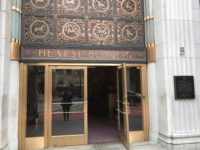
The word “reveal,” according to Merriam Webster’s Collegiate Dictionary, means “to make (something secret or hidden) publicly or generally known.” Or, according to Merriam-Webster online, reveal means “to disclose, divulge, or tell.” In screenwriting, “the reveal” generally comes near the end of the script, when the viewers finally become privy to hidden information that explains all that came before.
The most interesting stories written by professional journalists include a reveal. This can happen in a feature story or profile, but in investigative journalism, the reveal can make or break a story, not to mention the reporter’s career. The reveal may be startling, but the revelation must be true, in mainstream journalism.
Recently, I attended a luncheon sponsored by The Center for Investigative Reporting (CIR), which was held in downtown San Francisco at Local Edition, an underground bar featuring a newspaper theme. According to the Local Edition website, the bar is inspired by the newspaper business of the 1950s and ‘60s. Appropriately, Local Edition is located in the historic Hearst Building.

The entrance to Local Edition is easy to miss; in fact, I walked by it twice before reaching my destination. A dusty looking front window reveals block shelves featuring four vintage typewriters. Inside, down a flight of stairs, there is a classic bar, with both high and low tables. Additional vintage typewriters are hung from the ceiling on canopies. The Reveal is a lovely tribute to an old-fashioned reporter’s bar.
On this particular day, Local Edition was set up with rows of tables and chairs to view a documentary film, Heroin(e). Heroin(e), a CIR-produced Netflix documentary, was an Academy Award nominated film in the Documentary Short category. While it did not win the Oscar, it is an important film about the toll drugs can take on a small community. Peabody Award-winning filmmaker Elaine McMillion Sheldon shows not only the tragedy, but the hope that can come through the efforts of individuals.
In Huntington, West Virginia, three heroic women fight against the opioid epidemic and for the lives of an untold number of people in the community. Their hope and faith and lessons learned can serve as a role model about how a community of caring can make a difference.
There once was a time in my life when the thought of being a reporter was hugely appealing. Straight out of college, I had the opportunity to meet a reporter for the old San Francisco Examiner, a Hearst newspaper that competed for scoops with the then privately owned San Francisco Chronicle.
Along with a friend from work, a journalism student, we met in a bar near the newspaper, a reporter’s hangout. In the late afternoon, the place was crowded, noisy and smoky. Smoking not only was more common in the late 1960s, it was also legal to smoke in restaurants, bars, and other public places.
While I never became a reporter, I support those who work to reveal and bring to light, sometimes at great personal risk, important issues of which we might not otherwise be aware. Investigative journalism and disclosure of true facts has never been more important than in today’s world.
Sources
The Center for Investigative Reporting. Wikipedia
Heroin(e). Reveal News
San Francisco Chronicle. Wikipedia
San Francisco Examiner. Wikipedia
Editor’s note: This post is dedicated to the memory of Ian Jackson, subscriber, supporter and contributor to Social Correspondence. Ian, Berkeley antiquarian bookseller and friend of a dear friend, is responsible for my knowledge of vintage typewriters and 19th century letter-writing etiquette.




